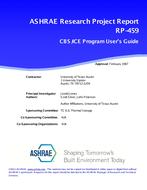This ASHRAE research project was a computational study of the factors that influence heat transfer in ceiling and floor plenums. The heat transfer phenomena in plenums are complex and include conduction, convection, and radiation modes. Using a nodal model, the sensitivity of plenums to various parameters such as convective heat transfer coefficients, surface conditions, and other model parameters was found. The required accuracy was determined for each variable to which the computer models were sensitive.
The public domain nodal program HLITE was used in the project. A companion program VLITE was used to solve for the radiation view factors. Three dimensional models of ceiling and floor plenums with a variety of air distribution schemes were examined. Commonly used fluorescent luminaires were modeled in significant detail, and the cases simulated a typical office space.
The peak cooling loads were found to be relatively sensitive in some cases to the convection coefficients between the room and the carpet, the room and the luminaire diffusers, and between the concrete slab and the floor plenum when there was unducted supply air. Overall, the energy was not very sensitive to the variables, and it is recommended that reasonable values be used in energy and load estimating programs. The ASHRAE Handbooks need more description of ceiling and floor plenums and their effect on load calculations and air distribution.
Product Details
- Published:
- 1996
- Number of Pages:
- 85
- File Size:
- 1 file , 2.2 MB
- Product Code(s):
- D-RP-787


